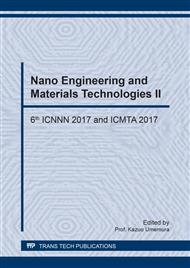p.115
p.120
p.125
p.130
p.134
p.139
p.147
p.153
p.161
One-Step FSP Synthesis of Nanocrystalline Fe/Al2O3 and Fe-Ce/Al2O3 Catalyst for CO2 Hydrogenation Reaction
Abstract:
Nanocrystalline Fe/Al2O3 and Fe-Ce/Al2O3 catalysts doped with various amounts of cerium were prepared using the one-step flame spray pyrolysis (FSP) technique. The characterization of the catalysts was measured by several methods such as X-ray diffraction, nitrogen physisorption and hydrogen temperature programmed reduction (H2-TPR) techniques. The results revealed that the FSP-made catalyst exhibited the characteristic pattern of FeAl2O4 phase without any phases of aluminum or iron oxide. In addition, cerium (Ce) dopant did not alter crystal structure at low content. However, 7 wt% content of cerium dopant resulted in the formation of ceria (CeO) and iron oxide (Fe2O3) phase. The catalytic performance of the FSP-made catalyst was tested in carbon dioxide hydrogenation for selective production of long chain hydrocarbon, and was compared to conventional impregnation-made catalysts. In the comparison, the FSP-made catalyst exhibited lower catalytic activity but possessed a higher long chain hydrocarbon selectivity. After doping with Ce, the catalytic activity was improved while the hydrocarbon selectivity was decreased and shifted to the short chain hydrocarbon product. In the case of conventional-made catalysts, the activity remained unchanged but the hydrocarbon selectivity was decreased. Among all catalysts, the FSP-made Fe-Ce/Al2O3 catalyst with 3% Ce-promoted catalyst exhibited the best performance in terms of selectivity to long chain hydrocarbon.
Info:
Periodical:
Pages:
134-138
Citation:
Online since:
March 2018
Price:
Сopyright:
© 2018 Trans Tech Publications Ltd. All Rights Reserved
Share:
Citation:


